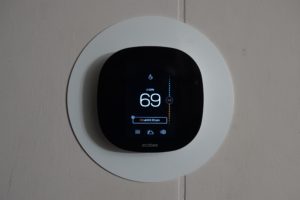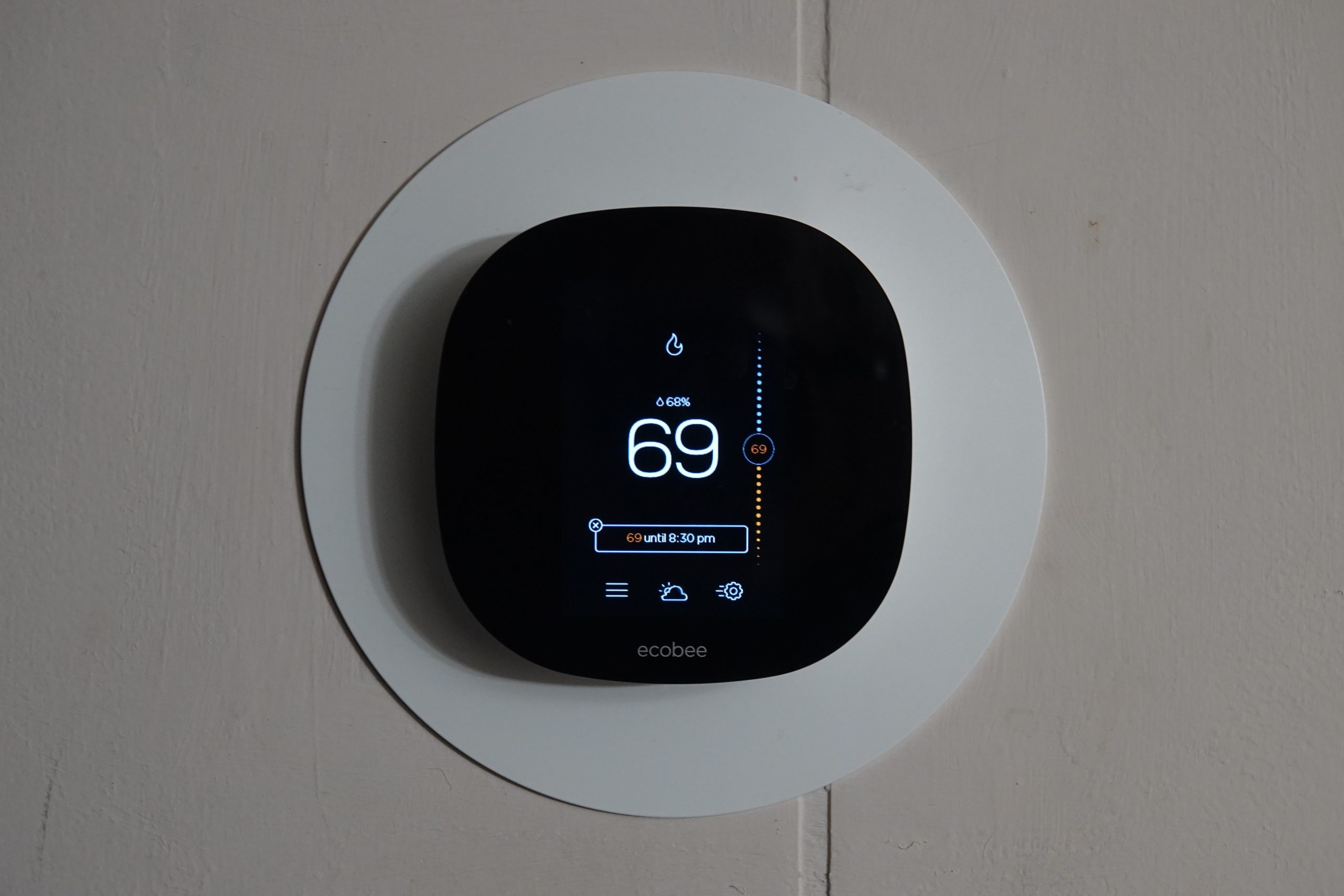This post may contain affiliate links which means I may receive a commission for purchases made through links.

Some heating & cooling systems can control how they work to regulate the temperature in various rooms independently. As a result, you’ll have more control over the temperature of each zone or area than in more simple systems. However, to ensure that each room in your house is regulating temperature to the desired setting, you’ll need a thermostat that supports zoned systems. If you already have multiple heating & cooling zones in your home, you can consider upgrading to a modern device like Ecobee smart thermostat. But does Ecobee work with zoned systems?
Well, read on to learn how zones work and whether Ecobee smart thermostats can be used to control heating and cooling in multiple zones!
What are Heating & Cooling Zones?
Most homes, especially those with forced air systems, usually have 1 furnace that heats the entire house. As a result, all the rooms get almost the same amount of heating when the furnace is turned on. However, while these systems work well enough, they can lead to unwanted temperature differences around the home.
To avoid this problem, you can install a more effective system like the one used in hotels, allowing you to control the temperature of each room independently. Unfortunately, this approach is not convenient or cost-effective for most homes.
Instead, some homes are set up with heating and cooling zones, instead of regulating the temperature of each room independently. That way, each zone is equipped with a dedicated thermostat to control the level of heating/cooling it experiences.
There are 3 ways to create zones with separate heating & cooling preferences within a home. One, you can install dampers in the house to control airflow to certain zones only. Secondly, your house can have multiple heating/ cooling units such as 2 furnaces. Lastly, your house can combine dampers and multiple heating & cooling units.
Dampers are commonly used in zoned heating & cooling systems since having multiple furnaces is usually too expensive. Besides, dampers work like a valve since they’re located within ducts. This allows air to flow freely from the furnace into the room vents when the damper is open.
For instance, if you have a 2-story house with 2 zones, one upstairs and one downstairs, the ground floor requires heating on a cold day, but not the 2nd floor. As a result, the thermostat downstairs will trigger the furnace to run, but the damper will prevent air from flowing to the upper zone. However, if the upper zones become too cool, the thermostat triggers the damper to open, heating both spaces. Such a zoned system depends on only 1 furnace but needs a thermostat in each zone as well as a zoned control board at the furnace to regulate which area receives the heat.
Will the Ecobee smart thermostat work with zoned systems?
Yes! You can use Ecobee smart thermostat to control each zone of your HVAC systems. However, to control each heating & cooling zone independently, you’ll need an Ecobee thermostat in each zone. Next, log into the Ecobee website and set up multiple thermostats as a group to function together and prevent them from working against each other.
In return, this will give you more control over your home’s temperature regulations and help you get the most use of your Ecobee device. For instance, Ecobee allows you to create up to 16 zones to regulate your home’s temperature. As a result, you can manage 16 different rooms on the same Wi-Fi network right from your phone, saving you the unnecessary work of getting many thermostats for your home.
Moreover, the Ecobee smart remote sensor connects up to 32 devices to your Ecobee smart thermostat. This feature will help you get a much more precise temperature reading of various places within your house.
If you already have multiple Heating & Cooling zones, switching to Ecobee is a relatively easy task. Nonetheless, there are a few key points you need to consider.
First, to control multiple zones in your home with Ecobee, you have to connect multiple thermostats to a zone control board. Otherwise, you cannot use a single Ecobee thermostat to control multiple zones. That way, each thermostat will control a single zone. So, if you’ve got 3 heating & cooling zones in your home, then you’ll need 3 thermostats.
Luckily, as already mentioned, Ecobee allows you to group these thermostats to prevent them from functioning against each other. This means that they can communicate with each other, allowing them to heat and cool different zones at the same time,
Will Ecobee remote sensors give your home multiple zones?
The Ecobee remote sensors significantly increase the function and sophistication of your heating & cooling systems. First, they monitor the temperature in more areas than just where you mount your Ecobee smart thermostat. This allows them to monitor the temperature in different areas of the house and throughout each zone in case of multiple HVAC zones.
Another interesting feature of these remote sensors is that they can monitor your presence. So, if you’ve multiple zones in your home, you can use these sensors to heat the occupied areas. For instance, if you’re upstairs, the systems will recognize your presence and set the spaces as the heating priority. As a result, the dampers will close off to the ground level and direct all the heat to the upper level. And when you move downstairs, the system will adjust the dampers accordingly.
However, contrary to what some users think, installing multiple Ecobee smart sensors does not create heating and cooling zones in your home on its own. This is because most homes only have 1 furnace and don’t have dampers. So, while the remote sensors can monitor the temperature in various areas/ rooms within the house, all areas are heated at the same time when the furnace is turned on.
How to Use Ecobee with Multiple Zones
Controlling multiple heating 7 cooling zones in your home with Ecobee is as easy as using 2 conventional thermostats. Besides, the setup is relatively straightforward and offers you greater control, using the existing thermostat wiring in your home.
With that in mind, here are some of the steps you need to follow when setting up your Ecobee thermostats with multiple zones;
1. Remove the old thermostats
Remove all the old thermostats in your home since you’ll need an Ecobee thermostat for every zone. For instance, if you have 3 old thermostats in various places, you’ll need 3 Ecobee thermostats to replace them. After removing the old thermostats, use the enclosed stickers to label each wire for easy identification.
2. Install the power Extender Kit (Optional)
If the old thermostats didn’t have a Common wire (C-wire), you’ll need to install the included Ecobee Power extender kit. The power extender kit is installed at the zone controller, which is usually located near the heating/cooling system.
So, head to the zone control panel and look for the zone wire where you’ll be installing an Ecobee thermostat. Remove all 4 thermostat wires from the panel and connect them to the power extender kit. Next, connect the power extender kit unit to the control board including the C-wire port to ensure there is a constant power supply to your Ecobee thermostat.
3. Attach the Wall mount
Go back to the location of the old thermostat and install a wall mount for your Ecobee thermostat. Use the included bolts to secure the plate to the wall and push each labeled wire into the appropriate port.
4. Set up your Ecobee smart thermostat
Use the Ecobee app or display to set up your thermostat, ensuring that you’ve named each unit correctly. Next, connect any remote sensor and pair it with the corresponding thermostat for that particular zone.
5. Group multiple zones through the Ecobee website
Sign in to the Ecobee website using the same credentials you used for the app. Look at the upper right-hand corner of the site and select the ‘thermostat groups’ option. Now, choose the setting you want to share with the organized group of Ecobee devices in your home to confirm that they work with all the zoned systems.
Can you install 2 Ecobee smart thermostats in one house?
As mentioned earlier, if you’ve multiple HVAC zones in your home, you’ll need multiple Ecobee thermostats in each zone. So, yes, it’s possible to have 2 or more Ecobee thermostats in one house, especially if you have a zoned heating & cooling system. As a matter of fact, you can have as many Ecobee units as you have heating & cooling zones in your home. However, having 2 Ecobee thermostats in your home doesn’t automatically create 2 zones. Instead, you have to establish the zones first when installing your HVAC system.
It’s also worth mentioning that Ecobee smart thermostats without Wi-Fi access work as they just function like conventional thermostats. Also, some features like the home/ away feature will not work, while the display will only show the time of the day and temperature.
In addition, you’ll be unable to control them through the website or app. In zoned HVAC systems, the devices will still turn the heating and cooling units on and off, but they’ll no longer work as a group.
Final Word
Overall, Ecobee is one of the best smart thermostats for controlling multiple heating zones in your home. Using Ecobee thermostats to work with zoned systems gives you much control over your heating & cooling system while helping you save energy each year. Best of all, Ecobee allows you to connect up to 16 thermostats and 32 room sensors to one wireless system to create zones as an organized ecosystem! That way, you can easily make changes to any smart thermostat in your home’s zoned heating & cooling systems right from your phone.
